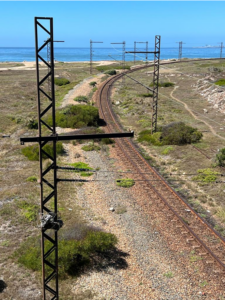- Perspective – November 2023
- Columbus Stainless Advert
- Best of the GPS Newsletter
- State of the Stainless Steel Nation
- Education & Training
- NDE Advert
- Global Webinar Report Back
- Industry Insight – Price of Carbon Emissions
- Member News Cronimet
- Cronimet Advert
- Market Intelligence – Zambia: A rising economic powerhouse
- Professional Profile – Jeanré Hanekom
- Technical Case Study
- Fastenright Advert
- Technical Case Study
- Industry News – Manufacturing Indaba 2023
- Sassda News – Gauteng Golf Day
- Member News – Columbus Stainless Awards
- Obituary – John Rowe
- Pferd SA Advert
WHY STAINLESS STEEL IS THE LOGICAL CHOICE FOR ELECTRIFICATION PROJECTS IN CORROSIVE LOCATIONS
The lingering (mis) perception that stainless steel is a more expensive choice of metal needs to be extinguished for once and all. Granted, the initial cost of the material may be higher but as this classic 3CR12 stainless steel Case Study points out when it Comes to structural applications, particularly those in coastal applications, its superior lifespan and corrosion resistance properties coupled with its minimal maintenance costs, make it the logical and quite frankly responsible procurement choice in key strategic projects…
Sustainability and Life Cycle Costing: The 3CR12 Electrification Masts Case Study
Corrosion is the natural, gradual deterioration of metals reacting with their environment. It degrades the useful properties of metals and structures including their strength and structural integrity. In the ambient environment, most metal alloys tend to revert to their natural stable states. Carbon steel, for example, is made up of iron and a combination of other alloying elements. Without any additional surface protection, they tend to form a layer of rust (iron-oxide); which is brittle and exfoliates, exposing a new fresh layer of steel to be attacked. This cycle continues with devastating effects on equipment and structures due to resultant loss in through-thickness and inevitably causing perforation - and low life.
When choosing metals for longevity and low maintenance, stainless steel becomes the obvious choice. Stainless steel selection is primarily concerned with corrosion resistance in a particular environment. Aesthetics is often important and thus the ability of the stainless steel to resist discolouration becomes critical. Cleanability and hygiene considerations may dictate the stainless steel finish along with aesthetic considerations.
Stainless steels have a unique advantage in that a thin, tenacious, and self-repairing passive chromium oxide layer forms on the surface of the steel. This oxide layer gives the steel its characteristic corrosion-resistant properties in most environments. The steel must contain at least 10.5% chromium for this passive layer to form. Stainless steels are known for their superior corrosion resistance and are used in the bare mill finish without the need for additional protective coating systems to enhance corrosion protection.
This brings into consideration a concept known as Life Cycle Costing (LCC) - which takes into consideration the initial material input cost, fabrication costs, maintenance and refurbishment costs, cost of lost production due to downtime and replacement cost over a defined product lifespan. Stainless steels have higher input costs compared to some competing materials; however, because of the characteristic corrosion resistance in most environments, they can maintain structural integrity without the need for additional surface coating systems or corrosion allowances – which add to the initial costs of fabrication. Over the lifespan of equipment or a structure, stainless steels are often considered the most cost- effective, low maintenance, long-term and sustainable choice; due to less need for material replacement (new production) and being 100% recyclable and manufactured using recycled material.
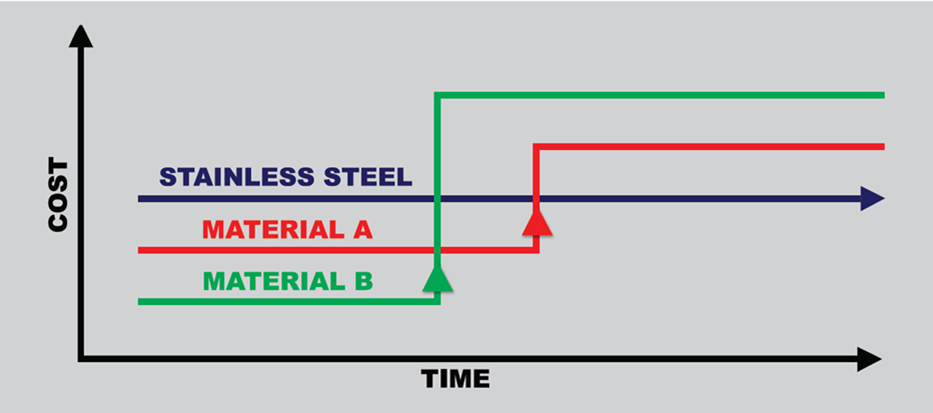
With atmospheric corrosion applications, material selection based on these considerations may lead to the following generalised conventional wisdom, summarised in Table 1; according to SANS10400-L.
Table 1: Minimum grade for stainless steel by SANS 10400-L
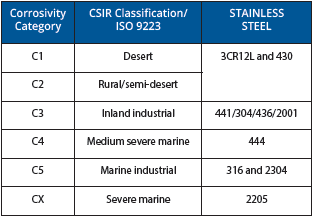
This material selection philosophy traditionally results in structures and fabrications built with good corrosion resistance and stain resistance. But it can be a costly solution.
Figure 1 demonstrates the stainless steel options for the various environments versus the corrosion resistance (using an empirical pitting resistance formula, derived from our laboratory pitting test results) and cost. In this specific case study, instead of using the conventional wisdom detailed above, an alternative approach was taken. Note: If the material selection criteria are low corrosion resistance and structural integrity, then 3CR12 is the solution. This is a proven low-cost stainless steel solution with a fifty-year track record in all atmospheric environments.
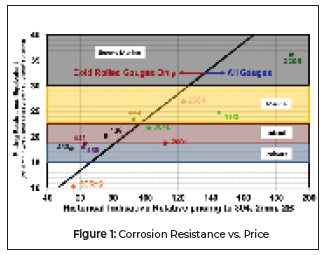
Figure 2 shows the results of a 20 year exposure programme that was conducted in various corrosive atmospheres around South Africa. Although the actual corrosion rate of 3CR12 varied from 0.001 μm/annum in a rural environment to 1.6 μm/annum in a severe marine environment, the relative corrosion resistance of the various metals was quite consistent. Based on this exposure testing, 3CR12 would be expected to last about 150 times longer than mild steel. From a structural integrity (pitting) point of view, the maximum pit depth observed in 3CR12 was in a coupon in a severe marine environment and even in this case, the pit depth was only 0.25mm after 10 years.
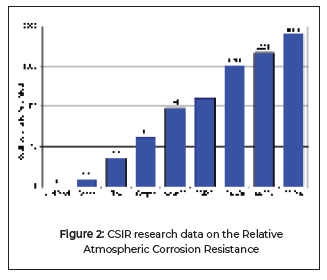
3CR12 is a 12% chromium-containing ferritic stainless steel, but unlike normal ferritic stainless steels, it is tough, even at temperatures as low as -30°C - and this toughness is retained even if it is welded. Conventional ferritic stainless steels exhibit low toughness (DBTT) and limited weldability and can therefore only be used in cold rolled applications with a maximum thickness of 3mm. 3CR12 as well as the austenitic (304L and 316L) and duplex stainless steels (2001, 2304 and 2205) are all tough, even when welded and can therefore be used in all thickness ranges.
Resilient Rail
In 1982, 3CR12 electrification masts were installed for the railway line from Gqeberha (Port Elizabeth) to Barkley Bridge; that runs for over 30km of track from the harbour along the coast to the North End, moving inland.
During high tide and windy conditions, the masts are constantly exposed to the sea spray (as illustrated in the pictures below). For these aggressive coastal environmental conditions, conventional galvanised or coated mild steel was not deemed suitable for the 40-year-maintencence free life required. For this reason, the metal of construction selected was the utility ferritic stainless steel grade 3CR12 (1.4003), a world renowned alloy invented and manufactured exclusively by Columbus Stainless. This material bridges the gap between coated carbon steels and the traditional higher alloyed stainless steel grades.
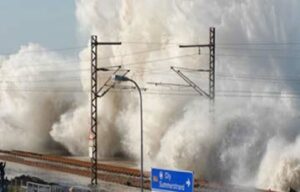
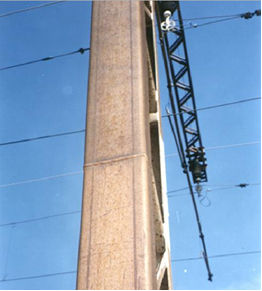
Figure 3 (a-b): 30 year inspection – taking note of the sea spray on the structures. Note: The original forming marks can still be seen on the metal surface, signifying the negligible metal loss.
3CR12 was chosen for the lattice girder masts and beams on the line including the entire system in the harbour area. An inspection of this original application in intervals of 14 and 30 years later found that there has been no measurable corrosion or evidence of pitting corrosion, and the system is expected to remain completely maintenance free for at least the original intended 40 years. This proves that the longevity of the product and minimal maintenance are critical attributes to consider when selecting construction materials.
3CR12 was supplied in the hot rolled and annealed (HRA) black finish. When exposed to elements over time, this surface finish forms a brown patina (discolouration) – which is not corrosion. It is simply aesthetic in nature. For the duration of this installation, the electrification masts have maintained this brownish appearance with no significant metal loss measured. Note: In structural applications where a stained (brownish) appearance is unacceptable or an aesthetic appearance is of importance, 3CR12 can be painted. As far as paint is concerned, 3CR12 has proved to be a substrate which contributes significantly to improved coating performance compared to mild or galvanised steel for numerous generic coating systems. Coated mild steel or galvanised steel sees significant underfilm creep and corrosion, especially in marine environments if the coating becomes damaged. With 3CR12, underfilm creep and corrosion are avoided. 3CR12 does not show a tendency to underfilm creep.
It can thus be seen that conventional wisdom for stainless steel selection for various environments applies where aesthetic concerns are the main criterion. If excellent corrosion resistance and structural integrity are the primary materials selection criteria, then alternative wisdom would suggest that 3CR12 is the obvious choice from a performance and cost point of view.
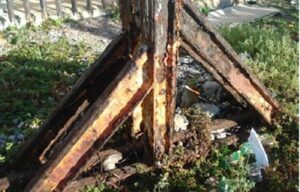
Figure 4: A carbon steel rail buffer in the same area showing excessive corrosion and subsequent loss of structural integrity
